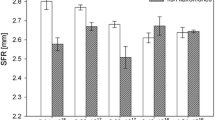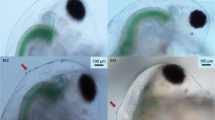Abstract
The life history of Daphnia exposed to fish kairomone at different developmental stages was examined in a laboratory experiment. The strongest life history response to the applied predation threat was observed in females exposed during the 4th instar. Compared to Daphnia experiencing the presence of fish at earlier or later instars, these individuals reached maturity at a smaller size and released fewer neonates. Moreover, their offspring also demonstrated the strongest reaction to predation threat, exhibiting the broadest phenotypic plasticity in the life history response to predation. The breadth of their reaction norm was, on average, two times larger comparing with individuals from other treatments. Broader phenotypic plasticity may offer clear selective advantages under the unpredictable predation regime. This finding highlights the adaptive role of maternal effect in shaping life history of cladocerans.




Similar content being viewed by others
References
Agrawal, A. A., C. Laforsch & R. Tollrian, 1999. Transgenerational induction of defences in animals and plants. Nature 401: 60–63.
Alekseev, V. & W. Lampert, 2001. Maternal control of resting-egg production in Daphnia. Nature 414: 899–901.
Dawidowicz, P. & C. J. Loose, 1992. Metabolic costs during predator-induced diel vertical migration of Daphnia. Limnology and Oceanography 37: 1589–1595.
Dodson, S. I., 1989. The ecological role of chemical stimuli for the zooplankton: predator-induced morphology in Daphnia. Oecologia 78: 361–367.
Dodson, S. I. & J. E. Havel, 1988. Indirect prey effects: some morphological and life history responses of Daphnia pulex exposed to Notonecta undulata. Limnology and Oceanography 33: 1274–1285.
Klüttgen, B., U. Dümler, M. Engels & H. T. Ratte, 1994. ADAM, an artificial freshwater for the culture of zooplankton. Water Research 28: 743–746.
LaMontagne, J. M. & E. McCauley, 2001. Maternal effects in Daphnia: what mothers are telling their offspring and do they listen? Ecological Letters 4: 64–71.
Lass, S. & P. Spaak, 2003. Chemically induced anti-predator defences in plankton: a review. Hydrobiologia 491: 221–239.
Mikulski, A. & J. Pijanowska, 2009. Maternal experience can enhance production of resting eggs in Daphnia exposed to the risk of fish predation. Fundamental and Applied Limnology 174: 301–305.
Mikulski, A., D. Lipowska & J. Pijanowska, 2004. Ontogenetic changes in Daphnia responsiveness to fish kairomone. Hydrobiologia 526: 219–224.
Mikulski, A., M. Czernik & J. Pijanowska, 2005. Induction time and reversibility of changes in Daphnia life history caused by the presence of fish. Journal of Plankton Research 27: 757–762.
Mosseau, T. A. & C. W. Fox (eds), 1998. Maternal effect as adaptation. Oxford University Press, New York, Oxford.
Riessen, H. P., 1999. Predator-induced life history shifts in Daphnia: a synthesis of studies using meta-analysis. Canadian Journal of Fisheries and Aquatic Sciences 56: 2487–2494.
Rossiter, M. C., 1996. Incidence and consequences of inherited environmental effects. Annual Review of Ecology and Systematics 27: 451–476.
Stibor, H., 1992. Predator-induced life-history shifts in a freshwater cladoceran. Oecologia 192: 162–165.
Tollrian, R. & S. I. Dodson, 1999. Predator induced defenses in cladocerans. In Tollrian, R. & C. D. Harvell (eds), The Ecology and Evolution of Inducible Defenses. Princeton University Press, Princeton.
Weider, L. J. & J. Pijanowska, 1993. Plasticity of Daphnia life histories in response to chemical cues from predators. Oikos 67: 385–392.
Acknowledgments
We are grateful to anonymous Reviewers who helped us to improve this manuscript. The study was supported by grant 0941/B/P01/2008/35.
Author information
Authors and Affiliations
Corresponding author
Additional information
Guest editors: M. Silva-Briano & S. S. S. Sarma / Biology of Cladocera (Crustacea): Proceedings of the VIII International Cladocera Symposium
Rights and permissions
About this article
Cite this article
Mikulski, A., Pijanowska, J. When and how can Daphnia prepare their offspring for the threat of predation?. Hydrobiologia 643, 21–26 (2010). https://doi.org/10.1007/s10750-010-0131-0
Published:
Issue Date:
DOI: https://doi.org/10.1007/s10750-010-0131-0




